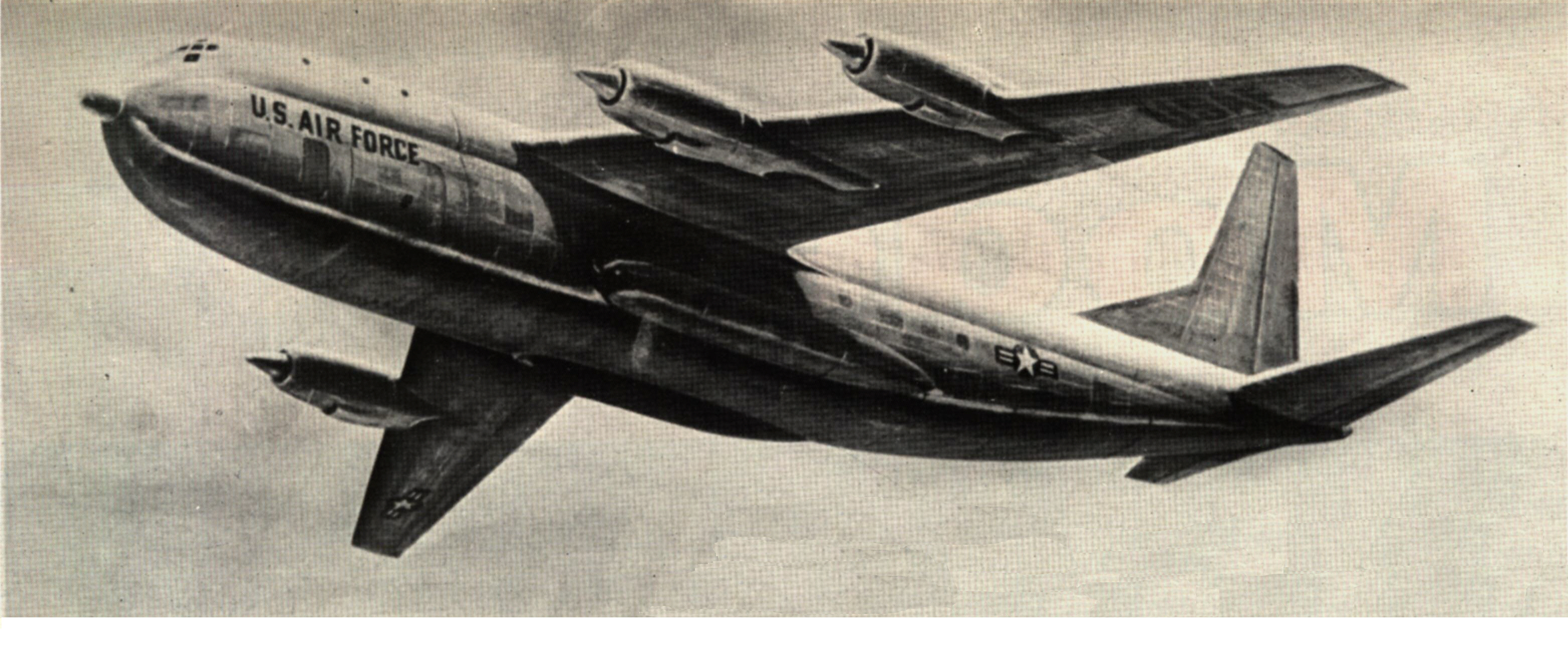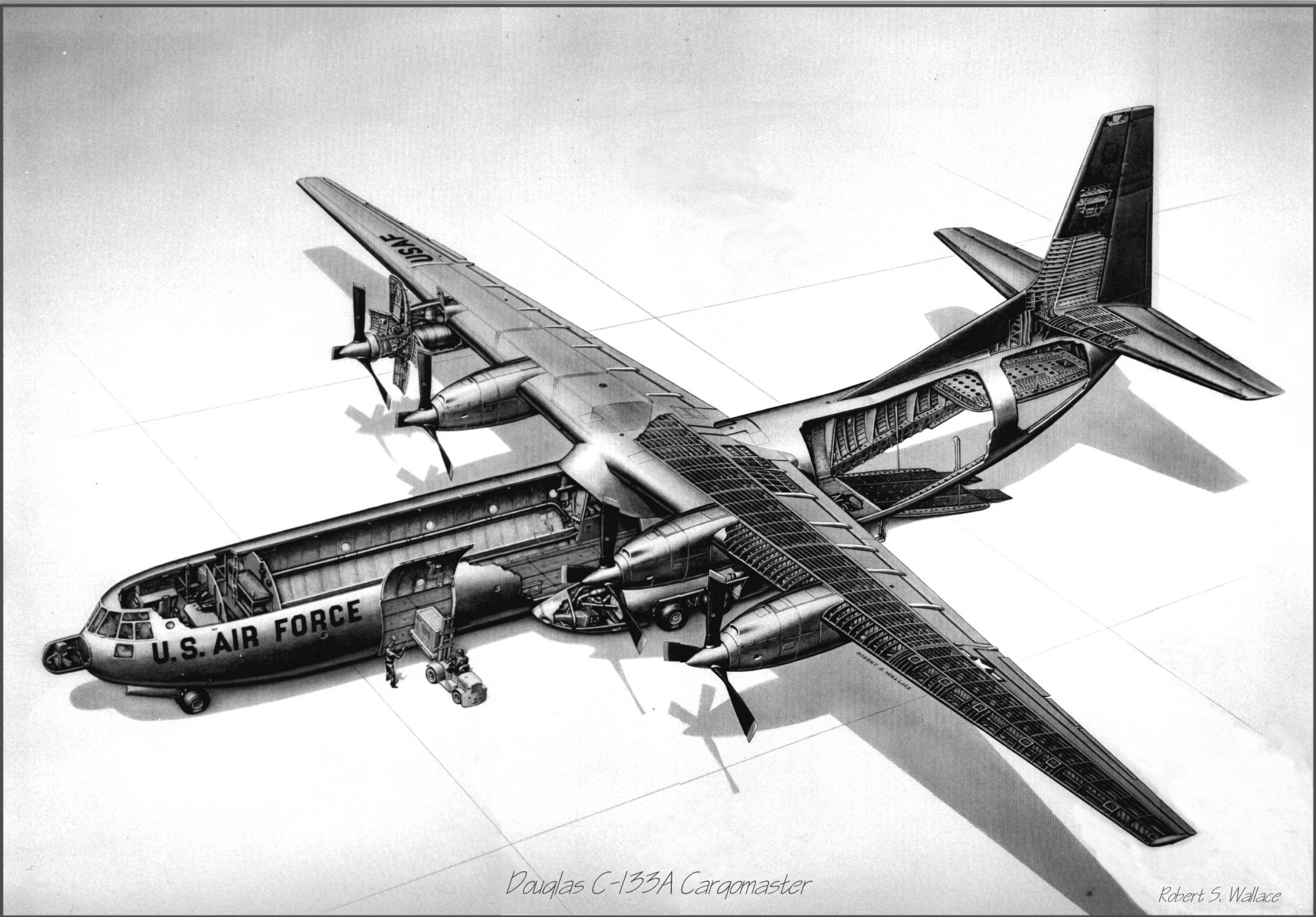| Home
| Project
| History
| Development
| Missions
| Accidents
| Tail
Numbers | Tech
Data | Units
| Gallery
| Links

C-132 in Flight (Artist's Concept) Air Progress 1955
Comparative Chronologies of C-133 and C-132
Because of the numerical sequence of Air Force designations, the
Douglas C-132 has been cited as a predecessor of the C-133. In fact, this is
not at all the case. Comparison of development timelines makes quite clear that
the C-133 came much earlier, and the Douglas model numbers confirm the
sequence. The C-133 was Douglas Model 1333, and the C-132 was Model 1814. The
following comparative timelines shows key steps in the process. Primary source
for C-132 dates was The "C" Planes, by Bill Holder and Scott
Vadnais.
C-132 (Douglas Model 1814)
C-133 (Douglas Model 1333)
Jul 50 Letter contract for YC-124B
Jan 52 Prelim specs for Model 1324 (C-124X), a pressurized
C-124.
Oct 52 Configuration decided as high-wing, rear loading truck
height deck with full pressurization.
Dec 52 Letter contract
Jan 53 Phase I design initiated
Feb 53
Douglas told to discontinue work on Model 1324, begin work on high-wing model
1333.
Mar 53
Detailed specs for Model 1333 submitted to AMC
Apr 53 Flight compartment mockup completed
Jun 53 Formal Spec DS-1333 submitted to AMC
Sep 53 AF confirms Model 1333 to be logistics carrier
Oct 53 Aircraft to be procured cut from 16 to 12
Nov 53 Formal Spec DS-1333 submitted to AMC
Feb 54 Mock-up started
May 54 Initial Phase II
Nov 55
Additional 17 aircraft authorized (total 29)
Dec 55 Phase II
Jan 56
First C-133 rolled out
Mar 56 AF asked Douglas to look at C-132 or C-133 to move Atlas
missiles from West Coast to Patrick
Apr 56 First C-133 flight
Feb 57 Six more C-133As authorized, last three mod for ICBM
hauling
Jul 59 (Est) First flight
C-132 Projected Performance
The
C-132 was proposed in two versions. One would have been a straight logistics
carrier, and the other would have served as an aerial refueler. The Air Force
made public announcement of the airplane on 14 Feb 57, to be built at the
Douglas Tulsa plant. If built, the C-132 would have carried a maximum payload
of 137,000 pounds a distance of 2,200 nautical miles, at a speed of 418 knots.
The tanker version was to have detachable tip pods with hose reels for probe
and drogue refueling, plus auxiliary internal tanks in the cargo compartment.
The idea was that the tip tanks and the internal tanks could be installed and
removed at enroute bases, an idea that might have proven more difficult in
practice than in theory. In the end, the C-132 progressed no further than a
full-scale mockup and inflight testing of the 15,000 shp Pratt & Whitney
YT57 turboprop engine mounted in the nose of a modified C-124. Some of the
lessons learned with the T57 were applied to the C-133s T34 engine to raise its
horsepower from 6,500 shp (T34-P-7WA) to 7,500 T34-P-9W).
XKC-132
performance data shown below comes from the same source as the three-view drawing
that follows.
The
drawing below, from a Douglas informational pamphlet, shows the tanker version
(Source: The XC-132 Logistic Transport and Inflight Refueler, Report No.
S.M. 14873. Douglas Aircraft Co., 1953, pg. 5.)
The color original of this drawing is in the Travis Air Museum
collection, Travis AFB, CA. It was originally done by Robert A. Wallace, a
Douglas Aircraft Company artist.

| Home
| Project
| History
| Development
| Missions
| Accidents
| Tail
Numbers | Tech
Data | Units
| Gallery
| Links
Copyright June 2000. Cal Taylor
All rights reserved.

| |||||||